Is a Mobile Defense a Viable
Option for a BCT?
By LTC Jon Anderson
Article published on: October 18, in the Winter 2024-2025 Issue of the infantry journal
Read Time:
< 10 mins
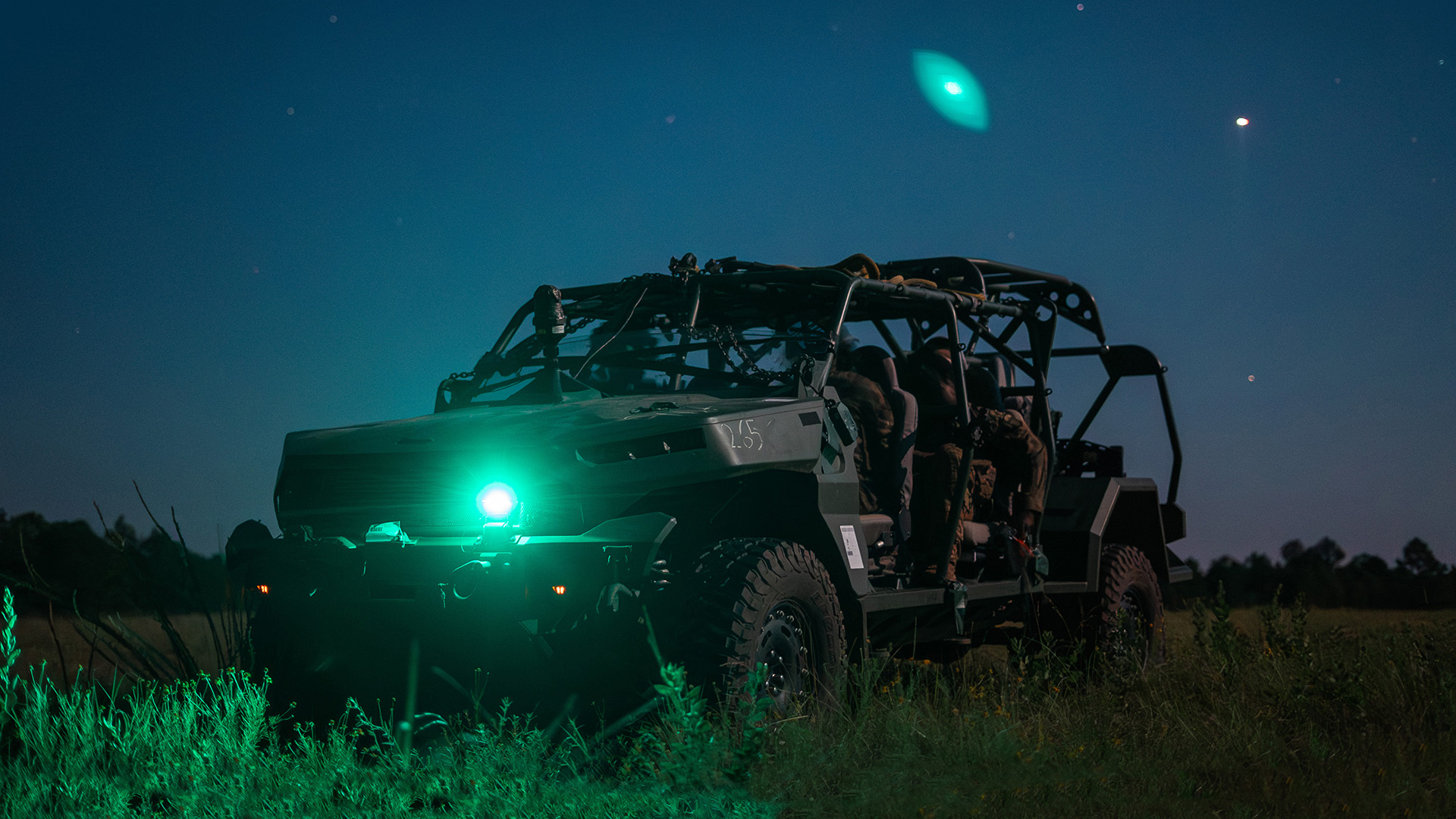
Soldiers from the 2nd Mobile Brigade Combat Team, 101st
Airborne Division (Air Assault) maneuver their Infantry
Squad Vehicle at Fort Johnson, LA, on 16 August 2024.
(Photo by SSG Joshua Joyner)
Imagine a combat credible force capable of fighting
further, faster, and in the fiercest conditions, creating
dilemmas for the enemy to a degree which has never
been seen before: a force that is specifically designed to
fight and win in severely restrictive terrain, with the ability to
rapidly reposition forces with organic mobility assets across
the battlefield, and that could strike deep behind enemy lines
through expeditious air assault operations. This fighting force
is the 2nd Mobile Brigade Combat Team (MBCT), 101st
Airborne (Air Assault), and it’s changing the paradigm of large-scale combat operations (LSCO). During Joint Readiness
Training Center (JRTC) 24-10, 2/101 MBCT maximized the
opportunity to experiment and validate concepts in the world’s
premier training environment against a fierce opposing force
(Geronimo), resulting in tactical, operational, and strategic
implications for the U.S. Army. While this creative approach
validated many concepts within the Army’s transformation in
contact concept, it also revealed unexpected outcomes. One
unexpected outcome is that, through the use of the Infantry
Squad Vehicle (ISV), the ability to conduct a mobile defense
(a type of defensive operation typically limited to division or
higher formations) is now a viable option for a mobile brigade
combat team. Utilizing the operations process as a framework (plan, prepare, execute, assess), this article describes
the actions of 1st Battalion, 26th Infantry Regiment during
Operation Strike Fury defensive operations and how they
showcased the capability of the ISV to rapidly move forces
across the battlefield as a dedicated counterattack force to
create conditions for the offense and allow 2/101 MBCT to
regain the initiative.
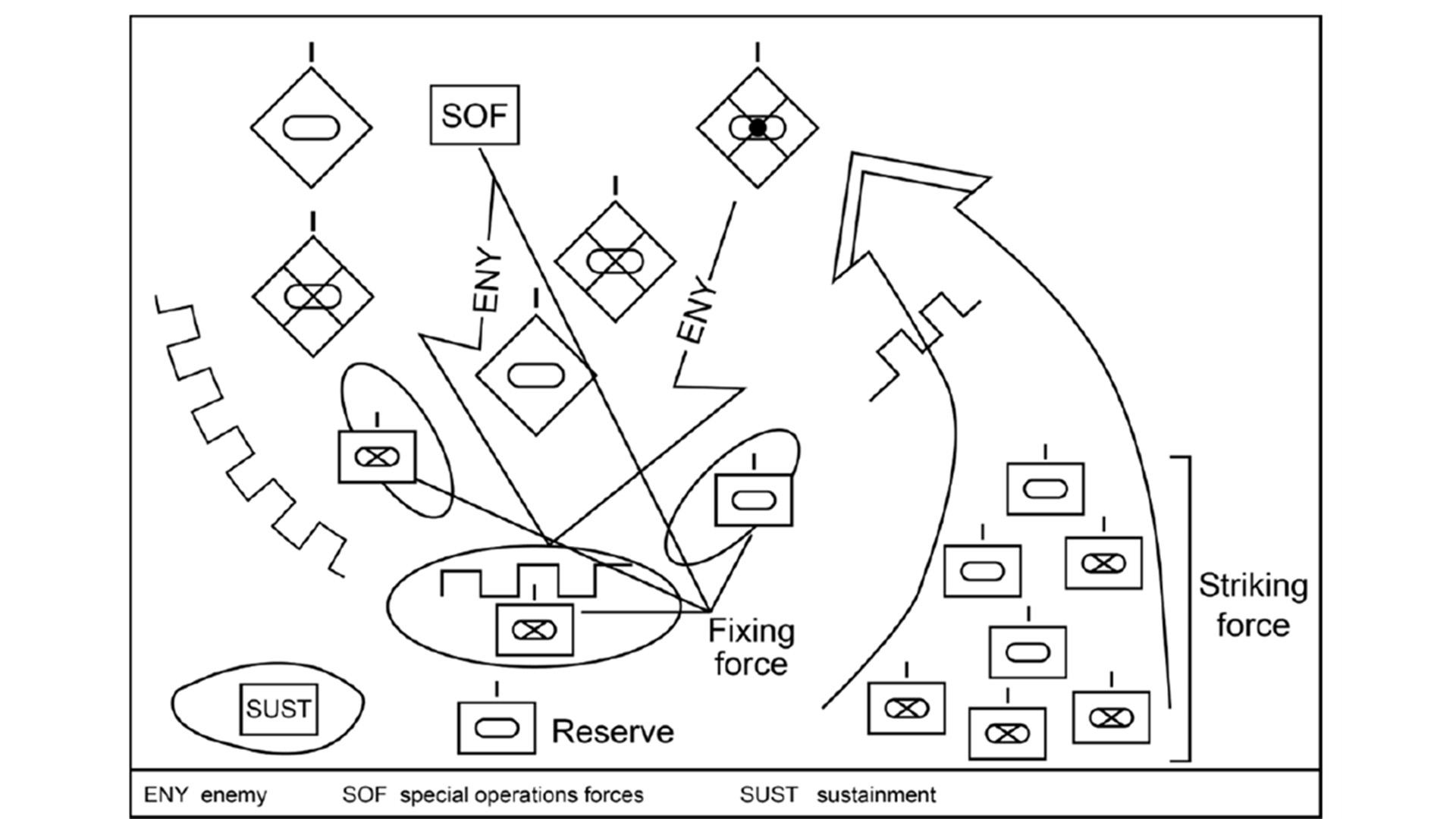
Figure 1 — Mobile Defense (FM 3-90)
Overview
It is extremely rare for a brigade combat team (BCT) to
conduct a mobile defense. Due to the resources required
and the size of the area of operations (AO), it is not typically
feasible for an element smaller than a division. However,
an MBCT, when properly task organized, contains all the
necessary resources to execute this type of defensive operation, to include reconnaissance assets, sustainment, and
an agile command and control structure. A mobile defense
is composed of three elements: the fixing force, the striking
force (where the majority of the combat power resides),
and the reserve. Chapter 10 of Field Manual (FM) 3-90,
Tactics, states that a “mobile defense focuses on defeating
or destroying enemy forces by allowing them to advance
to a point where the striking force can conduct a decisive
counterattack.” See Figure 1 for an
example sketch of a mobile defense.
In addition to the organization’s
available resources, there are three
key factors stated in section 10-3 of FM
3-90 that favored a mobile defense in
this scenario. The first is that frontage
assigned exceeds the defending force’s
capability to establish an effective area
or positional defense. Second, the depth
of the assigned area encourages attacking enemy forces to overextend and
move into unfavorable positions where
they are vulnerable to a counterattack.
Third, the time for preparing defensive
positions is limited. Although 2/101
MBCT did not deliberately plan a mobile
defense, over the course of the operation, the brigade implemented concepts
that closely resembled a fixing force and
a striking force to exploit the enemy’s
piecemeal attack.
Plan
The Operation Strike Fury defense was originally
planned as an area defense tied to terrain in the
northern and southern portions of the brigade’s AO
and connected by a large natural obstacle, Red
Leg Lake, in the center (see Figure 2). However, as
conditions changed, to include enemy actions and
the brigade’s understanding of the terrain, the agility
and flexibility of 2/101 MBCT gave the commander
unique options. This ultimately led to a modified plan
that utilized significant portions of a mobile defense
concept. The capability of the ISV proved critical to
shaping the course of the battle and gave distinct
advantages to the MBCT throughout the defensive
operations.
The original operational concept included 2nd
Battalion, 502nd Infantry Regiment (+Charlie
Company, 1-26 IN operational control [OPCON])
and 1-26 IN (Bravo Company, 1-26 IN and Brazilian Pioneer
Company) conducting an area defense in the north, and
1st Battalion, 502nd Infantry Regiment conducting an area
defense in the south, to include a detailed deception plan
using decoy emitters and proximate positioning of elements
of 1-26 IN to the east and south of the AO.
The commander’s intent was to project the commitment
of two battalions to the south, forcing the enemy to pursue
a perceived vulnerability to the north, which would give the
brigade’s main effort a distinct advantage. Upon confirmation
of the enemy’s commitment of forces north, the plan was to
rapidly reposition B/1-26 IN from the south to the north more
than 30 kilometers utilizing their ISVs, providing a defense in
depth to destroy Geronimo in detail. For reference, the ISV
carries nine Soldiers, reduces Soldier load through storage of Class I and V, and can rapidly transport maneuver elements
through restricted or unrestricted terrain (about 15mph in the
training area at night).
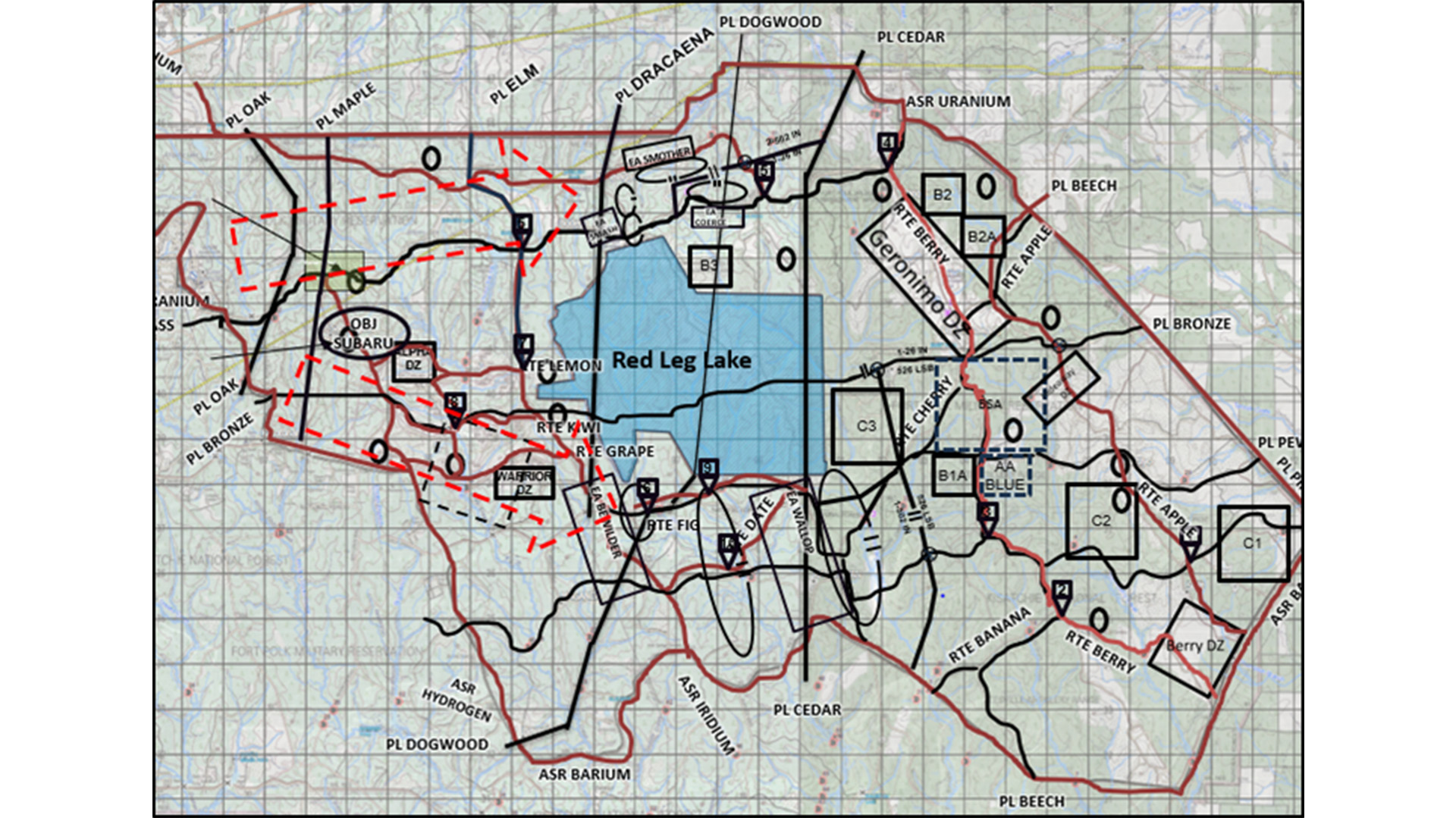
Figure 2 — Operation Strike Fury Operational Graphic
With this planning consideration, 1-26 IN can completely
reposition its forces more than 30 kilometers in less than 90
minutes. This addresses the issue of a BCT not normally
having the resources available to execute a mobile
defense; the fixing force sets conditions while the striking
force maneuvers into position to close with and destroy the
enemy. Additionally, the Blue Spaders implemented several
tactics, techniques, and procedures (TTPs) that maximized
the capabilities of the ISV while mitigating risk of exposure
with the enemy. For example, while on the move, 1-26 IN
utilized small unmanned aerial systems (sUAS) 500-1,000
meters in advance of its formations to identify enemy locations.
Another tactic that proved effective was to utilize the Modi
system on the move when the enemy sUAS threat was
likely. While at the halt, or while moving into attack positions,
platoon formations would move into a herringbone formation off the road and immediately conceal their vehicles
with camouflage netting. This allowed the Blue Spaders to
maximize their light infantry capability by making first contact
with sensors and scouts rather than driving into an ambush.
This set the stage to move into the preparation of primary,
alternate, and subsequent battle positions in preparation for
the attack.
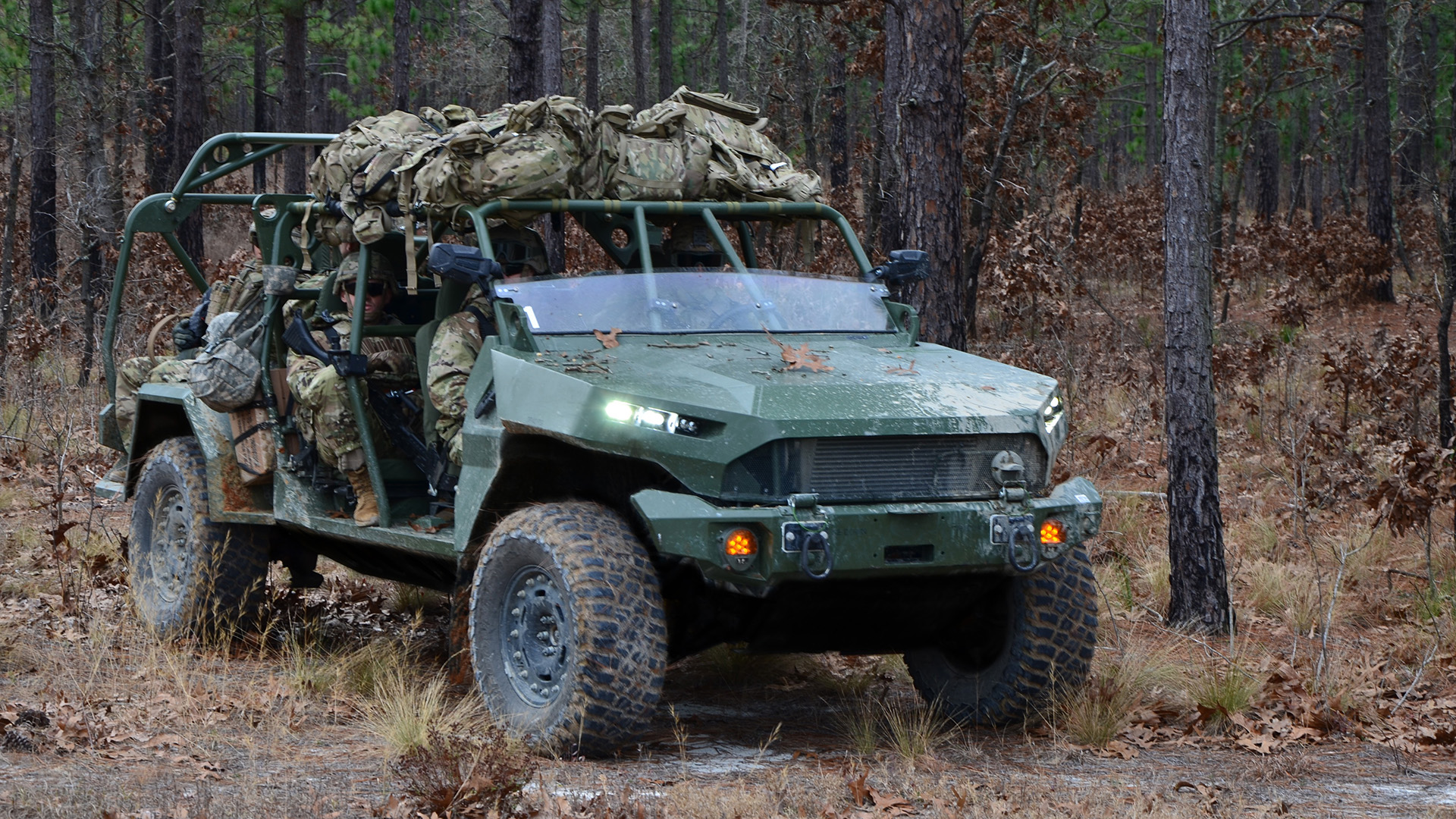
The operational requirements of the Infantry Squad Vehicle include the ability to carry nine Soldiers, a payload of 3,200
pounds, transportable by external sling load by a UH-60 Black Hawk helicopter, internal load/external lift by CH-47
Chinook helicopter, and exceptional mobility over all terrain, allowing infantry brigade combat teams to move with their
equipment over difficult terrain. (Photo by Michael J. Malik)
Prepare
Indications showed an enemy counterattack from the
southeast of the brigade, and 1-26 IN executed a fragmentary order to secure the brigade’s flank. B/1-26 IN served
as the main effort for this phase and constructed four battle
positions along key terrain to destroy enemy forces as they
attempted to attack the brigade’s rear area. The company
then utilized its ISVs to position forces along a 5-kilometer
front and conducted engagement area (EA) development by
integrating obstacles, fires, and key weapon systems along
the enemy’s most likely avenues of approach. However,
the enemy situation changed so 1-26 IN utilized its ISVs to
reposition more than 175 Brazilian light infantry soldiers to
the north from Berry Drop Zone to provide a defense in depth
of 2-502 IN. Over the course of two 60-kilometer round-trip movements, B/1-26 IN transported Pioneer Company
soldiers into their new AO, where they conducted continuous
EA development throughout the period of darkness. These
soldiers were positioned at the right time and place to destroy
enemy forces should they break through 2-502 IN’s defense
(see Figure 3, #1, for scheme of maneuver).
Execute
During the execution of the defense, Pioneer Company
destroyed 14 enemy vehicles and killed more than 30 enemy
in their engagement area. Concurrently, the multi-purpose
company (M/1-26 IN) provided early warning and security to
its northern flank through the use of its scout platoon, loitering unmanned systems (LUS) platoon, and anti-tank platoon
serving as the battalion reserve. A/1-26 IN was positioned at
a central location to the east of Red Leg Lake, approximately
15 kilometers from northern or southern brigade defensive
positions. During the course of the battle, A/1-26 IN was
committed north to the interdict the enemy’s advance upon
their penetration of 2-502 IN’s defensive position, essentially
serving as a striking force in the mobile defense concept.
A/1-26 IN was able to occupy its battle positions in the north
in under 40 minutes and in position to destroy the remnants
of the enemy formation. Simultaneously, B/1-26 moved more
than 20 kilometers to the south to conduct a counterattack
to the rear of 1-502 IN, as the enemy showed indications of
penetrating defensive positions to the south (see Figure 3,
Route #2 and #3 for scheme of maneuver).
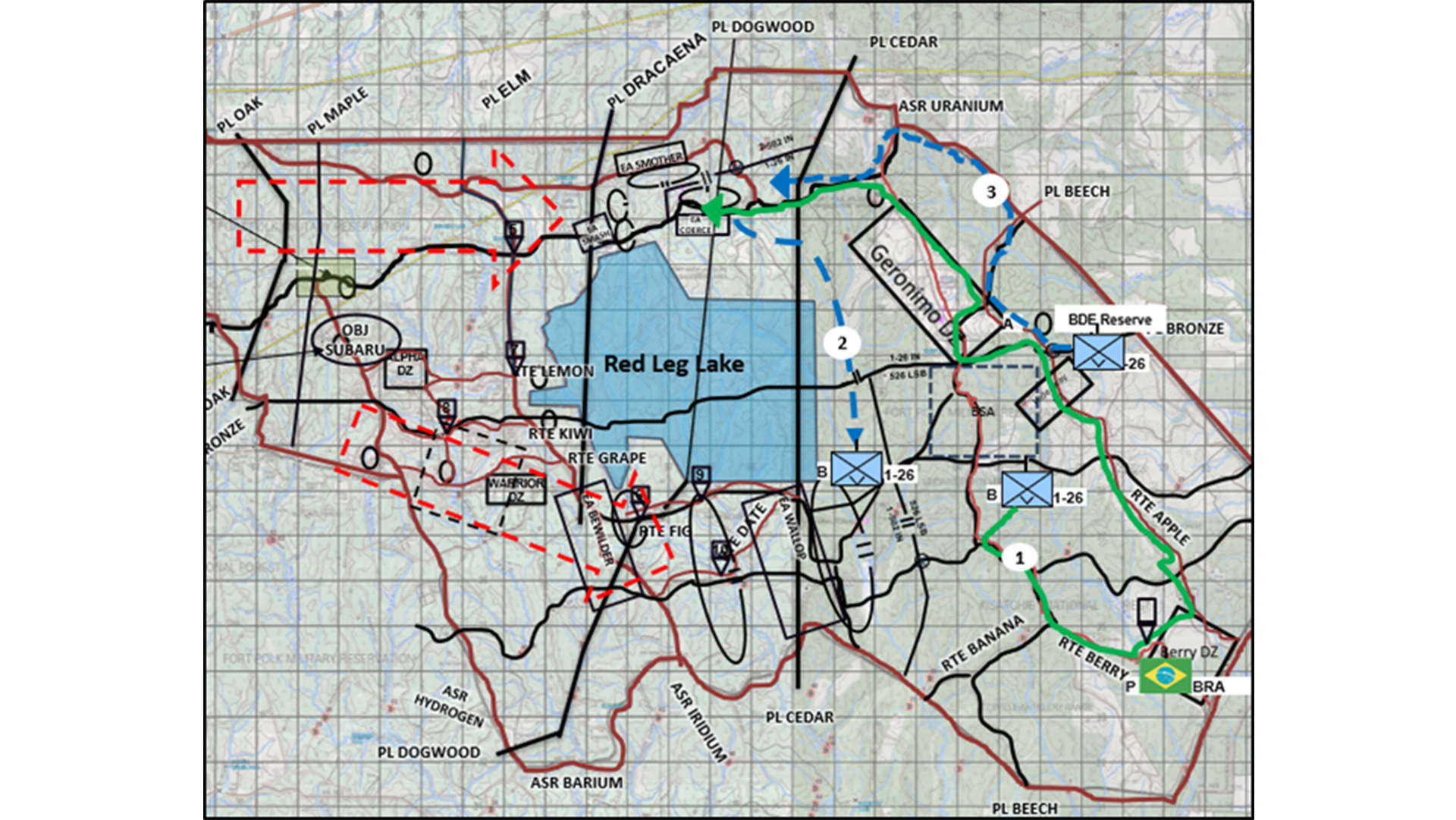
Figure 3 — This graphic depicts B/1-26 IN’s movement of the Brazilian Pioneer Company
(Route #1, shown in green), B/1-26 IN’s follow-on movement to its ambush position (#2,
shown in blue), and A/1-26 IN’s movement to its ambush position (#3, shown in blue).
Assess
Throughout the operation, the 2/101 MBCT commander
exercised options and positioned forces in a way that the
enemy was not expecting. This caused multiple dilemmas
for the enemy and desynchronized their attack at echelon.
Although this operation was initially planned as an area
defense, the brigade executed components of a mobile
defense that set conditions to rapidly transition to the offense.
The ISV proved to be a decisive capability for the brigade,
and the Blue Spaders demonstrated that through this platform, and the relentless pursuit of the enemy, the U.S. Army has a new way to fight and win
in the most austere conditions.
Without this capability, the
brigade would have had limited
options to exploit vulnerabilities
of the enemy and would have
been forced to commit to one
course of action in a vast area
defense. With this new level
of awareness in capability, an
MBCT should deliberately plan
a mobile defense — properly
weighting the fixing, striking,
and reserve force — to find, fix,
finish and follow through with
destruction of the enemy.
JRTC 24-10 was truly a
crucible experience for the individuals and organizations that
tested themselves in the heat
and pressure of Fort Johnson,
LA. 2/101 MBCT used this
rotation as an opportunity to
experiment and innovate with
new equipment and TTPs that
revealed critical lessons learned
for the U.S. Army. The lessons
learned throughout the planning, preparation, and execution
of the defense highlighted the fact that it is feasible for a
MBCT to execute a mobile defense. With further refinement
and innovation, this concept can be widely applied to similar
formations and executed in the most austere environments.
This new capability creates multiple dilemmas for the enemy,
and it is changing the paradigm in how an MBCT fights. This
crucible experience during JRTC 24-10 produced many
tangible results, with the most important being a more lethal
formation, ready to fight where we are told, to win while
relentlessly pursuing our rendezvous with destiny.
Author
LTC Jon Anderson currently commands 1st Battalion, 26th Infantry
Regiment, 2nd Mobile Brigade Combat Team, 101st Airborne (Air Assault),
Fort Campbell, KY. He previously served as a brigade operations officer for
the 4th Security Force Assistance Brigade, where he was responsible for
the unit’s security cooperation efforts across the U.S. European Command
theater of operations. LTC Anderson’s other assignments include serving
as commander of C Troop, 3rd Squadron, 4th Security Force Assistance
Brigade; senior associate athletic director at the United States Military
Academy (USMA); operations officer and executive officer of 1st Battalion,
41st Infantry Regiment, 4th Infantry Division, with a deployment in support
of Operation Freedom’s Sentinel; Soldier-Athlete and officer-in-charge of the
U.S. Army World Class Athlete Program’s wrestling detachment and the Total
Soldier Enhancement Training (TSET) program; commander of D Company,
2nd Battalion, 19th Infantry, and F Company, 1st Battalion, 19th Infantry
Regiment; and platoon leader and executive officer in A Company, 1st
Battalion, 23rd Infantry Regiment, to include a deployment to Iraq in support
of Operation Iraqi Freedom. He earned a bachelor’s degree in geopolitics
from USMA and a master’s degree in psychology, sport and performance
specialization.